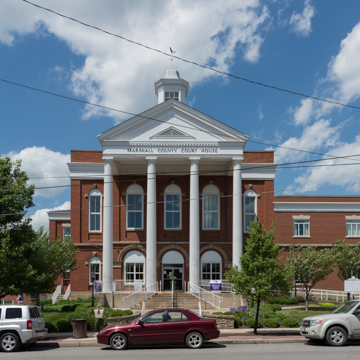Three years after Marshall County's brick courthouse was completed in 1876, J. H. Newton described it in his History of the Pan-Handle as “one of the finest and neatest county buildings in the state.” It was certainly the most ecclesiastical. Twin 70-foot high towers, capped with domes, flanked a porch that fronted a pedimented central block, an arrangement far more typical of Romanesque or Gothic Revival churches than of courthouses. Wheeling's C. C. Kemble received only $300 out of a total cost of $31,054 for his architectural services.
Early in the twentieth century, the towers were removed, the original one-story porch was replaced by a giant-order portico with tall columns, and a colonial-style cupola was placed on the ridge of the roof. Above the secondfloor windows, rows of corbeled brick left over from the building's Romanesque days were rendered superfluous, except to hint that something else used to be there. A more recent side addition follows the Colonial Revival precedents established in the first part of the twentieth century. If photographs of the original condition were not available, it would be hard to imagine the building as it once looked.

